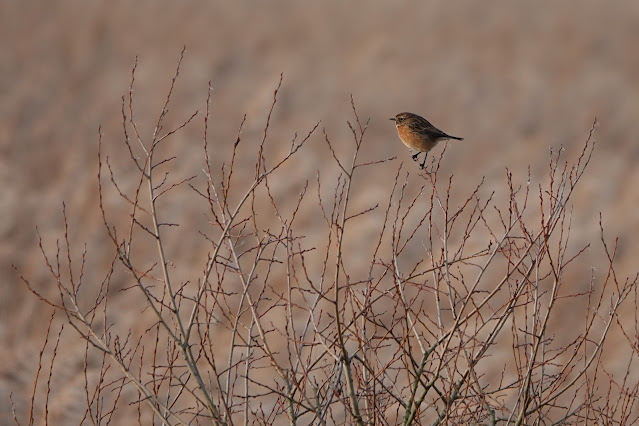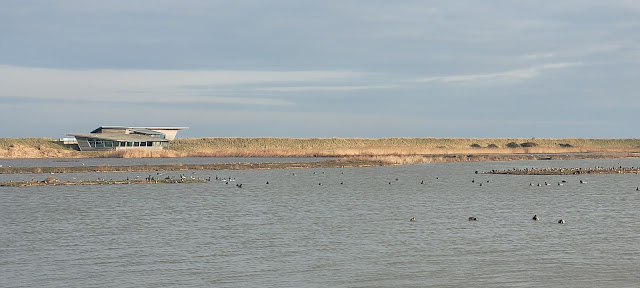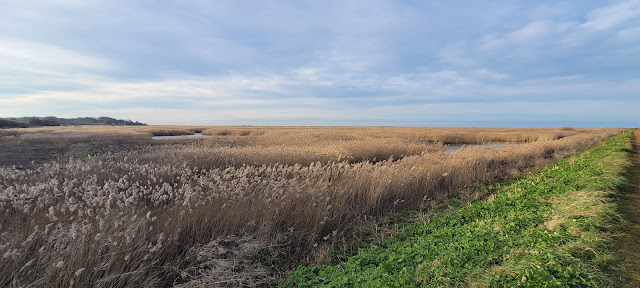A Blue Eyed Birder weekend away:
A slightly later start saw us wiggling northwards again but
with Titchwell as the start point. Our
route took us past the concrete pad in Brancaster where birders were looking
for the Cackling Goose but we could not see any as we drove by and
so pressed on to meet Richard and Roger.
Richard immediately informed us that the goose was actually still there
so we about turned and zoomed back up there and asked the all important
question. ‘Get the orange bag in the field below and go straight up, it is with
that bit of the flock…’ A few seconds later and this micro Canada poked his little
pied head through the throng of several thousands Pinkies. So ten points to Jim
for the directional suggestions the previous evening.
 |
| Cackling Goose - 'hutchinsii' - Jim Lawrence |
It was a fast feeding little goose and would reappear yards away from where you last saw it but occasionally it ended up in the open slightly and you could see the pale breast. I had only seen one in Norfolk before and that was way back in 1999 at Holkham and I seem to remember that one being darker breasted and with a little white half collar. I was always intending to have a look for this elusive and mobile bird today but was not expecting it to be seen so easily and quickly before we really started!
 |
| Cackling Goose - 'hutchinsii' - Mark Golley - exactly how we saw it |
Moving back to Titchwell saw us begin a leisurely stroll down
towards the beach passing Goldfinches and Chaffinches in the Alders but with no
Siskins or Brambling to be found. Bullfinches
called but I could not find them The feeding station by the centre is not what not
it used to be with just a couple of small hanging feeders and the whole range
of bird tables with rooves (for you to look at and then buy). The long wooden
beam with multiple feeders used to be full of finches and tits but now just the
odd Chaffinch was clearing up spillage and the Blue, Great and Coal Tits just
zipped in and out. The pond is a nice
addition but it could still be so much more.
A Muntjac poked around in the herbage while the first field held some enormous
looking normal Canada Geese.
 |
| Muntjac |
A Bittern had been showy in recent days in the track side
pools but we did not actually expect it to be there but sure enough it was
hunting around the margins and gave exceptional views. The blue cered male was intent on his fishing
and was unperturbed by the presence of his admirers although there was the
usual grumbling about ‘reeds being in the way’.
It was a privilege to watch him stretch his neck out and slowly place
his bill tip in the water with his head cocked on one side so that he could see
through the clear surface to the fish beneath. Periodically he would switch sides
and have a go with the other eye.
 |
| Bittern |
After about 30 minutes we left him to his hunt for second
breakfast and moved on to the first hide where flights of Brent Geese were
arriving for a wash and drink amongst the dabblers that included some
immaculate Pintails and incredibly close vermiculated Teal. Two Avocet, Golden Plovers, Dunlin, Ruff,
Redshank and Ringed Plover were noted and a female Goldeneye was diving in and
out of the bathing Brents.
 |
| Brent Geese |
 |
| Teal |
 |
| Brent Geese |
Marsh Harriers were constantly on view and Red Kites could
be seen circling in the distance whichever way you looked and a male Peregrine cruised through spooking everything in sight.. The saltmarsh added an invisible calling
Spotted Redshank alongside visible Redshanks, Grey Plovers, Curlews and gleaming
Little Egrets but we could not find the Spoonbill while Rock Pipits and Reed
Buntings moved back and forth.
 |
| Reed Bunting |
 |
| Red Kite |
As we approached the sea a departing birder glumly informed
us that there was nothing out of the ordinary so we made it our task to change
that. The tide was well in and the foreshore was strangely empty of waders
although with a bit of scanning we did pick up a big flock of Bar-tailed
Godwits and Oystercatchers to the east towards the people thronged Brancaster
Beach while the odd Sanderling, Ringed Plover and Turnstone were eventually
found.
 |
| Bar-tailed Godwits |
The sea was a little choppier that Saturday but we
persevered and found a pair of chunky Eider, more spiky headed Mergansers,
gleaming Goldeneye and a hulking Great Northern Diver that was snorkelling not
far off shore. Several distant Fulmars were
noted along with wave skimming Red-throated Divers. Pleased with our selection
we started to walk back in the stiffening breeze adding a brief Water Pipit and
Black-tailed Godwits in the process.
 |
| The Godwit Channel - Enid Barrie |
The
Bittern had retreated back into the reeds so we opted for lunch but not before
a cracking Water Rail posed in the boggy ditch where we watched him in his
stripy britches tossing wet leaves left and right with gusto. |
| Water Rail |
Time for some lunch before a return to the Fen Trail to look
for the finches once again. There were plenty
of Chaffinches and Goldies still but nothing else and we scoured the mossy
understorey for dozing Woodcock but a thermal imager would have been the only
way to find one in all honesty. The viewpoints added nothing new so we opted to
push on and make the drive back east to Cley where we had a good chance of some
new species.
 |
| I do like a Wood Pigeon |
 |
| Stigmella aurella - it would be rude to go a whole weekend without one mine pic? |
 |
| Chaffinch - so smart |
 |
| Nodding Snowdrops |
The journey was quite productive with Kites and Marsh
Harriers, a field sitting Peregrine and a couple of Brambling that flew up into
a hedge with Chaffinches from a game crop at Burnham Norton. Amazingly we got all three cars parked up at
the East Bank and set off to look for the Long-billed Dowitcher. Our first view from the roadside path failed
to produce it although 23 Ruff were strutting around the pools with that
curious head down, head bobbing gait.
The cool breeze was slightly behind us on the way down and the low light
was illuminating the phragmites but it was a little gusty for Bearded Tits
although a female Stonechat was hanging onto a solitary Willow.
 |
| Stonechat |
The Snow Bunting flock was swirling around the shingle in the
distance and Richard had a hankering for some shots so zoomed on ahead.
Meanwhile a male Peregrine careened over the Bank spooking the Lapwings, Ruff, Wigeon
and unseen flocks of Black-tailed Godwits and amongst which was the Long-billed
Dowitcher dashing to keep up with larger companions. Unlike the other waders, this flock headed
straight for the pools within the Cley reserve but we were happy to see such a
distinctive bird in flight.
Down at the beach the swirling cloud of Snow Buntings could
be seen grovelling in front of a happy Richard (we counted 82 in an aerial
shot) before we started the walk back after checking a deathly quiet sea.
 |
| Snow Buntings - Richard Hanman |
 |
Snow Buntings - Richard Hanman
|
 |
82 Snow Buntings - Richard Hanman
|
News that the Cley Spy Long-eared Owl was on show again had
us picking up the pace and by the time we got back to the car we only had 18
minutes to get there before closing time.
I had not visited before and wrongly assumed that it was just off the
main road in Blakeney but it was actually a couple of miles inland in
Glandford! We made it with five minutes
to spare and the staff very kindly let us in to watch this snoozing beauty at
the back of their demo area. It may have
had a branch across its face but it did not detract from seeing such a fantastic
bird – and its eyes would almost certainly have been closed anyway!
 |
| Long-eared Owl |
Our fleeting visit was soon over so we chanced our luck and
headed back to Blakeney Harbour to see if we could locate the Twite flock but although
we had a glorious walk along the seawall as the sun called it a night and
illuminated the sky in shades of amber, peach and orange, the little finches eluded
us.
It was beautiful though and even the breeze had dropped
leaving us with the sounds of Brent and Pink-feet flocks coming in to roost,
flock of vocal Curlews and the calls of Grey Plovers, Dunlin, Oystercatchers
and Redshanks filtering across the exposed tidal creeks to where we stood in
silence. |
| Curlews |
 |
| Orange Sky - Pink-feet |
It was a near perfect end to the day. Back at the cars I
introduced Richard to the ducky wonders of the harbour pond collection before
we headed our separate ways in the rapidly failing light.
Our route back to Wymondham took us past a field with eight
feeding Brown Hares and two individual Woodcock that were silhouetted against the
last fiery embers of the sky.







































No comments:
Post a Comment